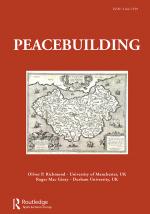Citation:

Abstract:
Violently contested cities are at the heart of ongoing ethnonational conflicts, and their final status is often a central issue for peace negotiations, without which no final resolution can be reached. These negotiations, typically led by national politicians and diplo- mats, include little, if any, representation of local actors and voices. These voices are often fundamentally different from those of state- centric actors, and they may bring to the table different ideas, values, and perspectives concerning the future of contested cities. This article integrates the seeing like a city theoretical approach with the growing literature on urban peacebuilding and asks: How is seeing peace like a city different from seeing peace like a state? and whether the visions of local pro-peace grassroots leaders are com- plementary or contradictory to the models that national decision- makers propose for cities. We analyse the case study of Jerusalem using historical analysis, public opinion surveys, and in-depth inter- views to illustrate the tension between state-centric and city-centric logics. Our findings show the distinction between the focus of state-centric processes on ‘rigid’ issues (e.g. security and sover- eignty) and the focus of city-centric processes on ‘soft’ issues (e.g. tolerance and daily life). We conclude the paper with an explication of the implications of our framework, seeing peace like a city for research and practice in other violently contested societies.
